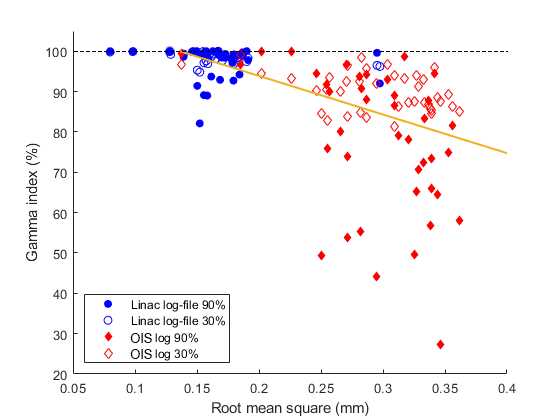Impact of log-file source and data frequency on the accuracy of log file based PSQA
PO-1709
Abstract
Impact of log-file source and data frequency on the accuracy of log file based PSQA
Authors: Akbar Azzi1, Gerd Heilemann2, Dietmar Georg2, Supriyanto Ardjo Pawiro1, Terry Mart1, Wolfgang Lechner2
1University of Indonesia, Physics, Depok, Indonesia; 2Medical University of Vienna, Radiation Oncology, Vienna, Austria
Show Affiliations
Hide Affiliations
Purpose or Objective
Patient-specific quality assurance (PSQA) using phantom measurements is time-consuming for an adaptive radiotherapy approach. Log file-based PSQA can be used to increase the efficiency of PSQA. However, log files can be obtained from various sources, such as Linac backups and third-party quality assurance tools, which contain different levels of detail. Another approach is the use of treatment data stored in the oncology information systems (OIS). In this study, the dosimetric accuracy of high-frequency Linac log-files and low-frequency log data stored in the OIS was compared.
Material and Methods
Treatment plans of ten brain cancer patients and ten head and neck (HN) cancer patients treated with volumetric modulated arc therapy were used. Log files from a single fraction of each patient were retrieved using Elekta’s Linac backup utility as well as the Mosaiq database. Using the scripting interface of the treatment planning system (TPS) RayStation, log file based radiotherapy plans were created. The recalculation was done using the same algorithm. The dosimetric differences of Linac log files vs. TPS and OIS logs vs. TPS were evaluated using gamma analysis with 2%/2mm criterion and dose threshold of 90% and 30% to evaluate the high dose and low dose gradient, respectively. DVH parameters of D98%, D50%, and D2% of PTV and maximum dose of spinal cord and brainstem were recorded. Moreover, the root mean square (RMS) error of MLC positions was calculated and correlated to gamma pass rate (GPR).
Results
Although the raw information of OIS log showed 0 MU at some control points, which did not occur in the Linac log-file, the MUs/fraction between the two logs showed the same value. The dosimetric difference between the dose distributions of the two logs compared to the TPS dose was insignificant for PTV D50%. A significant difference was found for PTV D98% and D2% (p < 0.001) for HN case and PTV D98% (p = 0.005) for brain case. The root mean square (RMS) error of the leaf positions of OIS log was approx. twice the RMS error of the Linac log-file. The GPR was 100% for RMS errors below 0.14 mm, while the GPR decreased with higher RMS errors (see Figure 1). The relationship of PTV D2% and GPR 90% threshold had a strong significant correlation (r = -0.78, p-value <0.05). Furthermore, 95% and 60% of the Linac log-files and OIS log data showed GPR >80% and PTV D98% and D2% < 3%, respectively.

Figure 1
Conclusion
Based on these findings, a tolerance level of 3% of the difference between PTV DVH was established. The prescribed dose calculated using the Linac log files and OIS logs was consistent. The data quality of the OIS logs was lower compared to the Linac log files, which is also visible in the lower accuracy of the total dose distribution calculated. Nevertheless, OIS logs can still be used for PSQA to detect coarse errors more efficiently and reduce the workload of experimental plan verification. However, an improvement in the data quality of OIS logs is necessary.